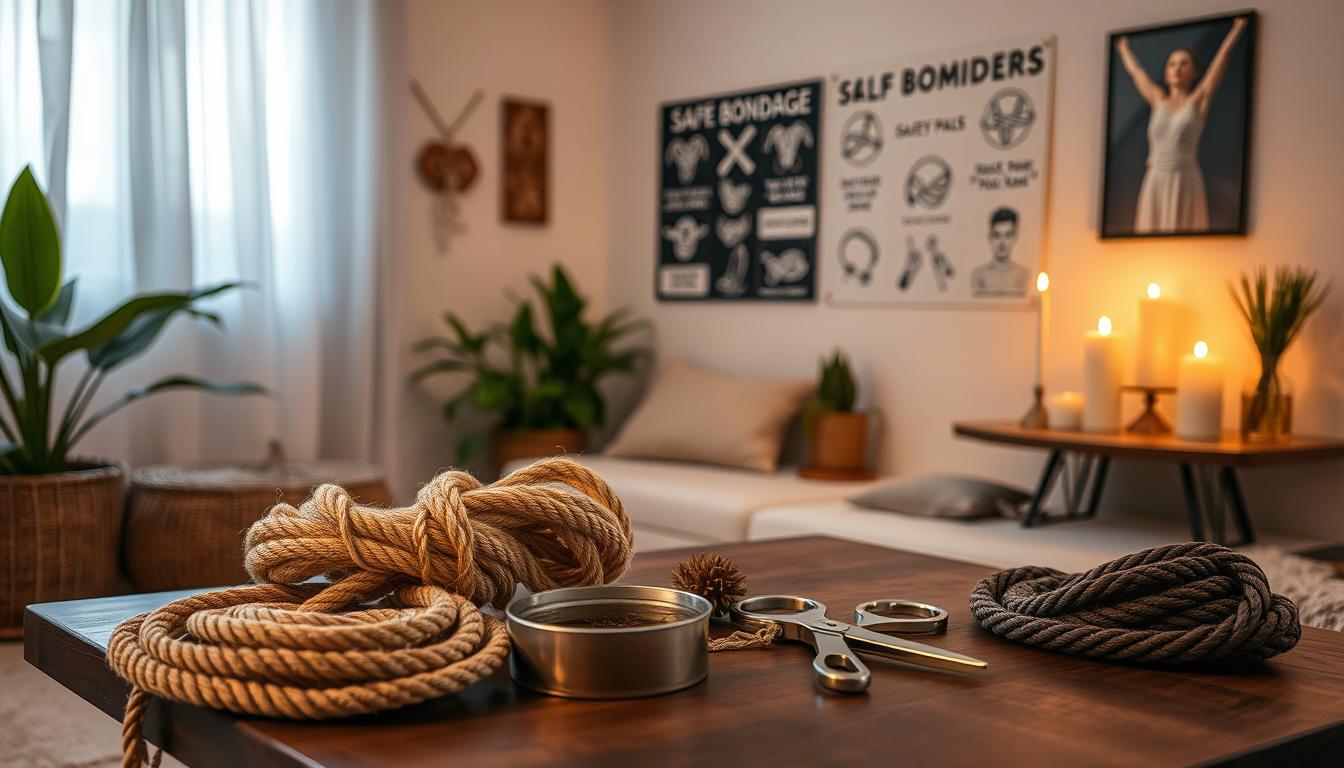Imagine the excitement of discovering new pleasure areas. It’s a path that’s thrilling yet needs to be safe. Self-bondage introduces you to erotic play, emphasizing on diving into fantasies while keeping safety a top priority. The thought of being restrained is intriguing but calls for attentiveness to dodge any mishaps, ensuring you stay safe. Through this guide, learn vital safety tips and explore various restraints that can make your BDSM adventure memorable, always remembering to be conscious of your actions.
Key Takeaways
- Always avoid tying anything around the neck area due to extreme danger.
- Consider that 90% of potential accidents in self-bondage stem from falling over.
- Prepare at least two backup methods of release for emergencies.
- Ensure ropes are not too tight with the “one finger” test for safety.
- It’s vital to monitor for symptoms like numbness or a bluish tint.
Understanding Self Bondage
Self-bondage is when someone ties themselves up for erotic fun. It lets people explore their sexuality by themselves. This activity is popular in the BDSM community for solo play. It gives the person doing it all the control. There are two main types: sensual, which is easier to get out of, and strict, which makes escaping much harder. It’s important to know what self-bondage is before trying it to stay safe.
Self-bondage is exciting but riskier than being tied by someone else. There’s no one to help if things go wrong. So, safety must come first in solo BDSM play. Learning to do it safely makes it more enjoyable and less dangerous.
Starting self-bondage needs care and planning. Many people share their set-up tips, stressing the need to know your body and safety needs. They suggest using emergency release tools and knowing your limits.
Exploring self-bondage can be fulfilling if done right. Knowing about erotic restraint and its risks is key when playing alone. This knowledge keeps the fun safe.
Types of Restraints for Self Bondage
Exploring different restraint types is crucial for a great self-bondage experience. Each restraint brings its own sensations and control levels. It’s important to know these options to choose safely and enjoyably.
Rope Techniques and Safety
Bondage ropes are popular for their flexibility. They allow for a range of methods, from simple ties to advanced shibari. It’s vital to use the right materials, as the wrong ones can harm your skin. Bondage ropes are made for safety and comfort. They let you adjust knots to fit your body.
Chains: Weight and Release Difficulty
Metal chains offer a unique feel in self-bondage. Their weight makes a distinct sensation. But, it’s important to think about how hard it can be to get out quickly in an emergency. Chains feel strong but can be risky. Always have a plan and a way to cut them if needed.
The Use of Plastic Wrap and Dangers
Plastic wrap is an interesting choice for restraint. But it can be very risky. It may cause suffocation or make you too hot if not used carefully. Ensure good air flow and have safety measures in place. It’s wise to have someone know your situation or a way to communicate in case of danger.

| Restraint Type | Pros | Cons |
|---|---|---|
| Bondage Ropes | Versatile, adjustable, engaging techniques | Improper materials may cause skin damage |
| Metal Chains | Unique weight sensation, secure feeling | Difficult release, potential safety risks |
| Plastic Wrap | Novel experience, tight fit | Suffocation risk, overheating dangers |
Safety Concerns in Self Bondage
Self-bondage comes with excitement and potential dangers. Knowing about safety is key to a good time. The mix of body and mind issues is very important here.
Blood Circulation and Its Risks
Using tight restraints can cause problems with blood flow. People might feel numb, get cold, or see their skin change color. These symptoms usually start slowly. This can lead folks to underestimate the danger they’re in. If a limb turns pale, cold, and has no pulse, you must act fast. To stay safe, it’s important to know how different everyone’s nerves can be, which parts of the body are at risk, and how long and tightly you’re bound.
Suffocation and Autoerotic Asphyxiation Risks
Be very careful with anything that might cause suffocation. Autoerotic asphyxiation is very dangerous because blocking the airway can kill. Stay away from anything that might make it hard to breathe, especially depending on how you’re positioned. Knowing the dangers in your surroundings and the methods you choose is crucial for safe self-bondage.
Psychological Considerations: Anxiety and Panic Attacks
The mental impacts of self-bondage can lead to anxiety or panic attacks. When things get intense, it’s normal for people to feel scared or upset. Managing these emotions well is key. Having a safeword and being clear with yourself helps make things safer and more enjoyable. Paying attention to these mental aspects helps keep the experience fun and safe.
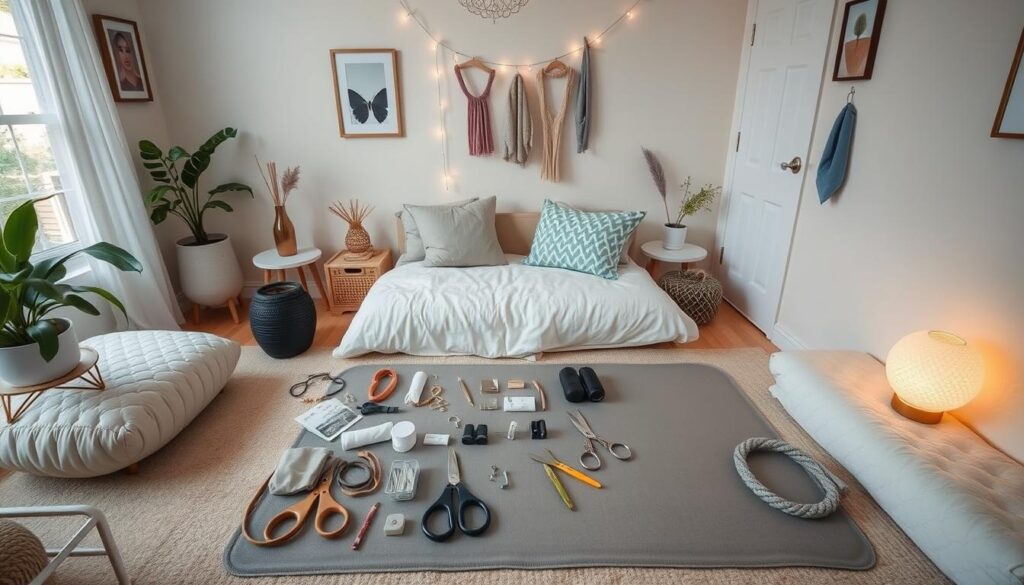
Planning Your Self Bondage Sessions
Planning self-bondage is key for both safety and fun. Getting ready for a session helps you lower risks and make the most of it. It’s important to do your homework and use smart strategies for a better self-bondage experience.
Importance of Research and Preparation
Before you start self-bondage, doing a lot of research is important. Knowing about different restraints, their uses, and dangers makes your session safer. Being prepared stops many problems and bad experiences that come from not knowing enough.
How to Test Restraint Techniques Safely
Start practicing with restraints on areas of the body that are not critical. This approach slowly increases your comfort and lets you see how your body responds to different materials. Testing in a safe environment helps you learn the limits and safety before trying more intense restraints.
Creating a Safety Protocol for Emergencies
Having a good safety plan for emergencies is crucial. First up, make an escape plan, including keeping tools like emergency scissors close. Make several copies of keys for any locks and think about where to keep them. Use a timer to keep track of how long your session lasts, staying alert the whole time.
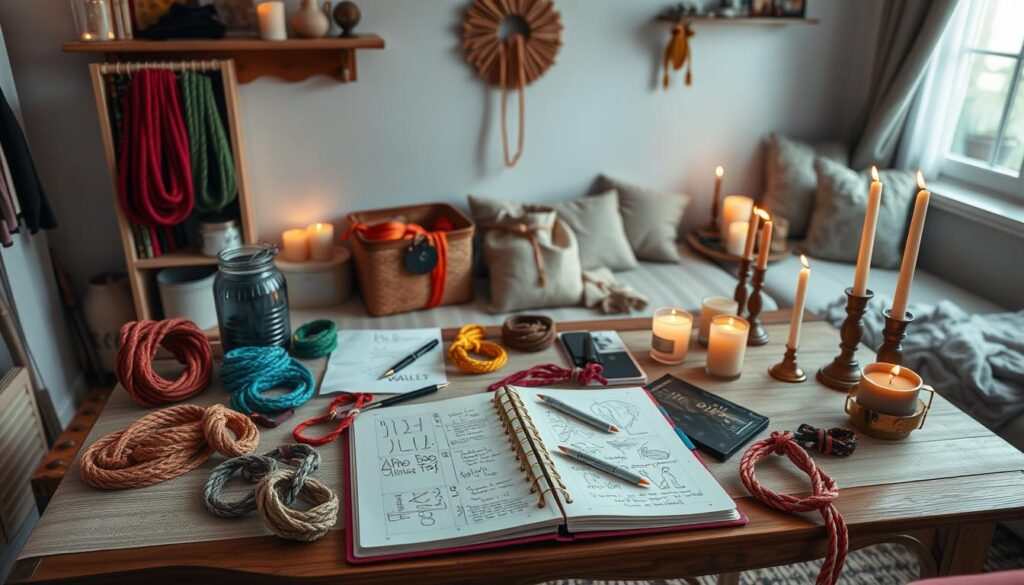
Essential Gear for Safe Self Bondage
Having the right self-bondage gear is key for your safety and fun. It helps create a safe space while lowering dangers. Here, we’ll talk about the essential items you should always keep close.
Scissors and Emergency Equipment
Every self-bondage set needs safety scissors with rounded tips. They prevent injuries and offer a quick escape in emergencies. You should also have bolt cutters for tougher restraints. It’s important these tools are easy to get to, giving you peace of mind.
Types of Locks and Safety Measures
Knowing about lock safety is crucial for self-bondage. Leather cuffs with locks are better for a strong hold than Velcro cuffs, which beginners may prefer. Always have a backup key close by or use a timer to release. When using blindfolds and gags, keeping in touch with a partner or friend is key for safety.
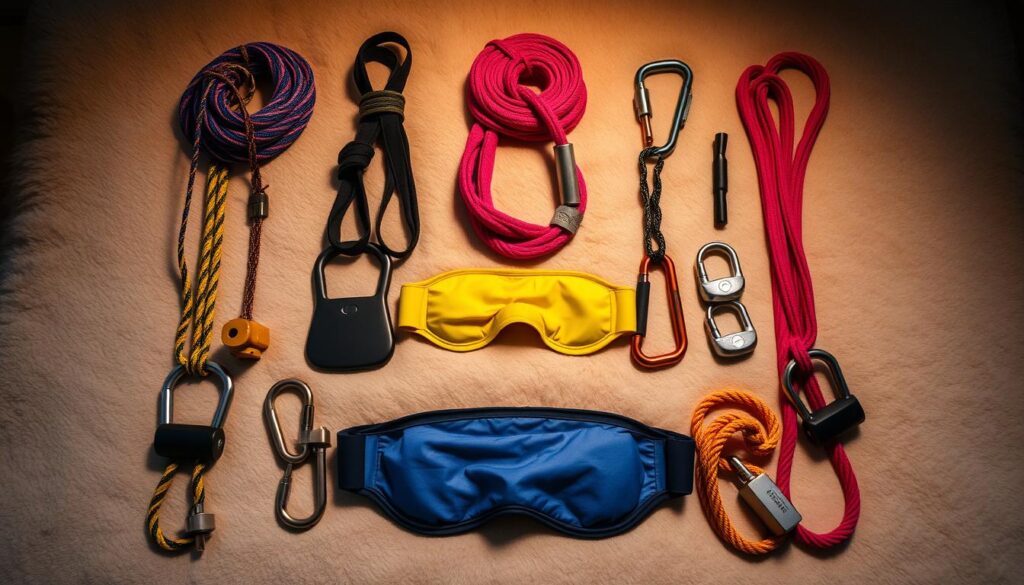
Handing Over Control: Sensory Play in Self Bondage
Adding sensory play to self-bondage can make your experience more thrilling. It helps make feelings stronger, both mentally and physically. This makes the adventure more rewarding. About a quarter of people into BDSM have tried self-bondage at least once, which shows it’s quite popular.
Using things like blindfolds can make your sense of restraint feel more intense. Tools that control sensations, like vibes or things that change temperature, can make things more exciting. Research tells us that 25% of those into self-bondage also play with temperature, bringing a special twist to their experience.
It’s very important to stay safe while trying out self-bondage. About 80% of people say having a way out is a top priority before starting self-bondage. Most prefer loose knots for easier escapes, keeping you safe as you explore your fantasies. It’s a good idea for beginners to use bondage tape because it’s gentle on the skin.

When trying sensory play in self-bondage, go with what feels right. Start with what you know, keeping control in your hands. Indeed, 70% report feeling more in control and learning more about themselves. As you get more comfortable, try new sensations with different materials or techniques.
| Aspect | Statistics |
|---|---|
| Individuals enhancing pleasure through self-bondage | 40% |
| Practitioners who have tried self-bondage | 25% |
| Preference for loose knots among enthusiasts | 60% |
| Individuals feeling control and self-discovery | 70% |
| Safety incidents due to improper measures | 15% |
| Comfort with handcuffs or rope for beginners | 55% |
| Participants with an escape plan | 80% |
| Sessions lasting over an hour | 30% |
| Preference for timed release in solo sessions | 10% |
| Combining sensory activities with self-bondage | 25% |
Trying sensory play with self-bondage can open up new exciting levels. Always know your limits and keep safety first for the best self-bondage experiences.
Staying Within Your Limits
Learning to read your body’s signals and set good boundaries is key to safe self-bondage. It’s important to know when something feels off. Spotting these signs quickly can help avoid any trouble. Make sure you have a plan for spotting discomfort and how to get out if you need to.
Understanding Your Body and Safety Signals
When practicing self-bondage, paying attention to your body is very important. If you feel numbness or tingling, it might mean your bondage is too tight. These feelings are cues to adjust or take off your restraints. Always check on yourself to stay safe and enjoy a good time without hurting your body or mind.
Time Limits to Avoid Overextension
It’s smart to set limits on how long you spend in self-bondage. Experts suggest picking a set time for each session. This keeps you from going too far and makes sure it’s enjoyable and safe. Clearly setting these limits, and perhaps using timers, helps manage your time well.

| Body Signals | Action Needed |
|---|---|
| Numbness | Readjust or remove restraints |
| Tingling | Check for excessive tightness |
| Increased heart rate | Pause and assess comfort |
| Stinging sensations | Release pressure immediately |
Enjoying self-bondage safely means knowing your limits and setting time boundaries. Understanding these can make your experiences better and safer. It’s all about having fun without putting yourself at risk.
Additional Safety Practices
Adding new safety measures makes self-bondage a lot better. It’s key to plan well to keep yourself safe. Always put your safety first.
Backup Plans and Escape Routes
It’s crucial to have backup plans for self-bondage. Make sure you have a safe way out if things don’t go as expected. Use locks that are easy to open, like MagBound® or Ice lock. These allow for a quick release.
Magnetic locks, such as MagBound®, are chosen by half of the users for their no-hands needed feature. Practicing how to escape can help you stay calm. In fact, 80% feel less worried knowing their escape routes well.
Avoiding Intoxication During Sessions
It’s very important to stay sober during bondage. Being clear-headed and quick to react is vital. Using substances can make it hard to deal with emergencies, raising the risk of getting hurt.
The bondage community agrees that staying sober means a safer, better time. Getting enough water and sleep before starting also helps you stay focused. This is something 80% of users have observed.

Self Bondage Techniques to Explore
Exploring self bondage is thrilling. Whether you’re new or looking for advanced techniques, you have many options. Safety is key when trying new things. We will look at strategies for beginners and those wanting to up their game.
Beginner-Friendly Restraints
Starting with beginner restraints is smart for newcomers. Using simple techniques can introduce you to the experience without too much restriction. You could try:
- Silky blindfolds for sensory play without too much limitation.
- Bondage tape, which is easy to use and comfortable.
- Adjustable leather wrist/ankle cuffs for a safe sensation exploration.
This method is about fun while staying in control. Always have a quick way to release your restraints. This ensures safety during your adventure.
Intermediate Techniques for the Adventurous
Ready for more after beginner restraints? Try complex self bondage for deeper sensations, always keeping safety first. Consider these:
- Steel handcuffs or chains for stronger restriction feelings, being mindful of your safety.
- Advanced rope techniques for unique positions and heightened sensations.
- Using a spinner app for controlled edging, blending excitement with discipline.
As you explore, remember your limits. Use a timer to keep sessions safe and have safety measures in place. Each time can be a new discovery, knowing when to stop is crucial.

SELF BONDAGE – Try Out Some New Tips To Have Fun And Stay Safe
Exploring self-bondage opens a door to enjoyable erotic play. However, safety always comes first. About 62% of people dream about trying BDSM activities. Knowing the best self-bondage tips can make the experience both exciting and safe.
When it comes to bondage, safety concerns are common. Ignoring safety advice can lead to bruises or abrasions. For example, 33% of those involved in bondage get bruises, and 25% suffer from abrasions. Learning to avoid harm makes your journey both exhilarating and secure.
The materials you choose are vital. Using the wrong items can cause circulation problems for 40% of users. It’s wise to use bondage materials that are wider than 6mm. This spreads the pressure out and keeps your blood flowing. Also, always tie hands last to prevent losing circulation.
Communication plays a key role in bondage. Around 80% of bondage enthusiasts highlight the need for a safe word. This shows that safety in self-bondage depends on consent and talking things through. Always discuss any health concerns before starting to ensure everyone stays safe.
Before your next self-bondage session, have safety shears close by to cut ropes if needed. Drinking water and eating a light meal before starting can boost both fun and performance. This allows for enjoyable erotic play without risking your well-being.
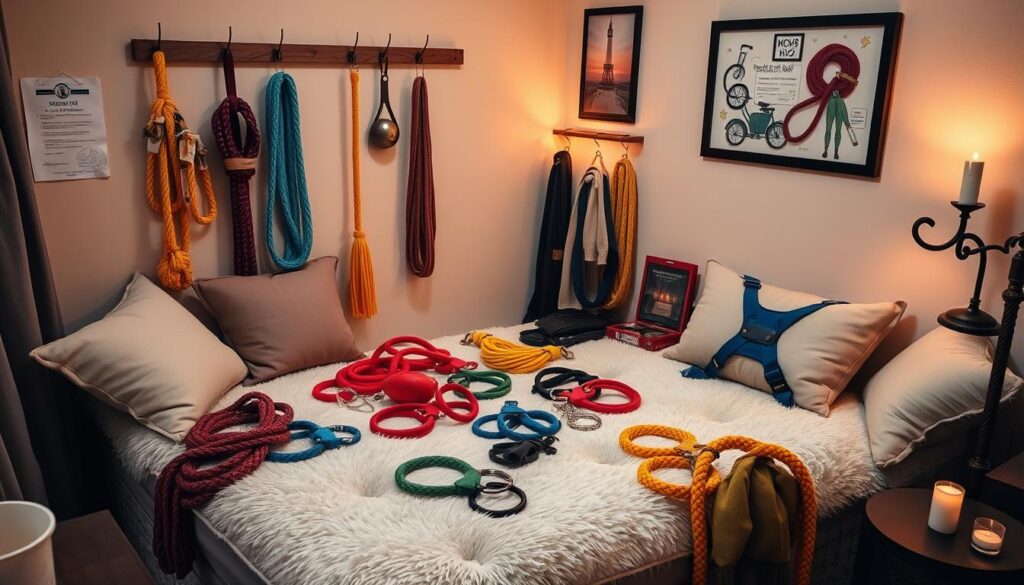
Further Educational Resources
Continued education is key for the safe practice of self-bondage. By learning from trusted sources, you gain important knowledge. This helps make your experience better and safer.
Books and Articles for Self Bondage Safety
There are many informative guides on self-bondage. They cover techniques, safety, and how to enjoy bondage more. Reading thorough BDSM books gives you a good idea of what to do.
Some good books to start with are:
- SM 101: A Realistic Introduction by Jay Wiseman – It’s a basic book on BDSM.
- The New Topping Book by Dossie Easton and Janet W. Hardy – Talks about safe and consensual topping.
- Playing Well With Others by Lee Harrington and Mollena Williams – This one’s about BDSM and polyamory.
Online Communities and Forums
Joining online forums lets you meet people who share your interests. These places are great for getting advice on self-bondage. You can also share your experiences.
Some well-known forums are:
- Reddit’s r/BDSMcommunity – A active spot for safe BDSM talks.
- FetLife – A social network for fetish and BDSM enthusiasts.
- The BDSM subreddit – Focuses on safety, techniques, and stories in BDSM.
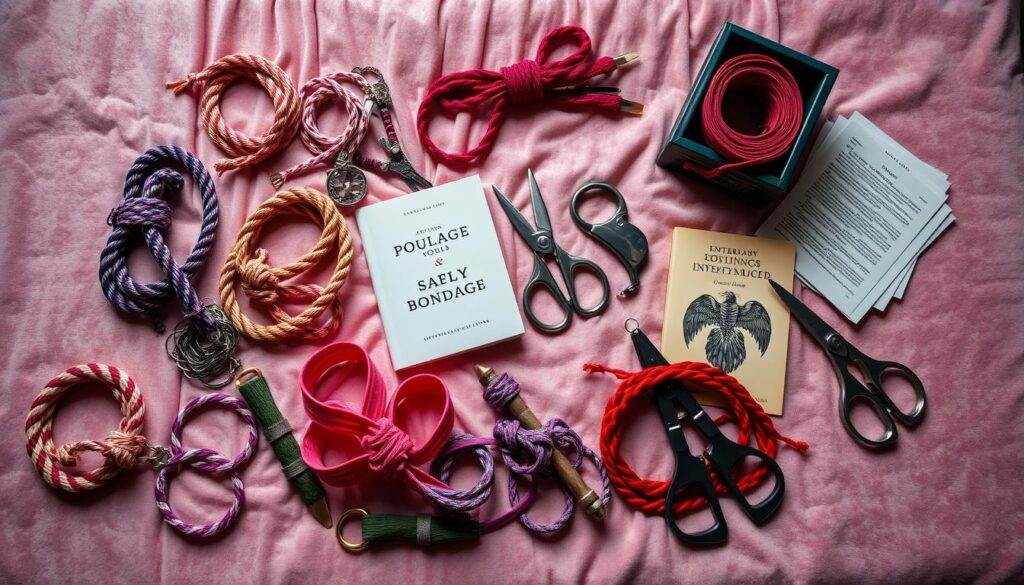
| Resource Type | Examples | Description |
|---|---|---|
| Books | SM 101, The New Topping Book | In-depth knowledge on BDSM practices and safety. |
| Online Forums | Reddit, FetLife | Platforms for community support and information sharing. |
| Articles | BDSM safety tips, consent guidelines | Practical advice on safe and consensual bondage. |
Using these resources can really help you understand self-bondage better. They ensure you keep safety and consent at the forefront.
Final Thoughts on Self Bondage
Thinking about your self-bondage reflections boosts both fun and safety. This activity lets you test your limits safely with good planning and knowing more. Always check and update your methods and tools to make your experience better.
Some key habits can make your self-bondage better. For example, getting your bondage gear and fetish wear ready ahead can save you 30%-50% time. This not only saves energy but also increases the pleasure of the experience.
Many, about 70%, suggest not eating 2 to 3 hours before to avoid discomfort. About 65% say having a safety knife close by is important, showing how crucial safety is in this exploration.
- 80% of people prefer color-coded ropes to cut down mistakes.
- Nearly 90% warn about the dangers of restricting blood flow and breathing, especially with neck ties.
- About 75% stress the need for good physical shape, like being flexible and strong.
Knowing your limits is key. Using mirrors or proper lighting can improve knot tying by 30%. This focus helps in doing it right and keeping it fun.
Adding things like blindfolds and various toys can make it more exciting. Around 40% say these enhance personal discovery, leading to more meaningful experiences.
Self-bondage leads to big growth, in mind and body. Planning carefully avoids risks. Each session teaches you more about keeping safe, as seen in your self-bondage reflections.

Conclusion
As we reach the end of our journey with self-bondage, it’s evident that it’s more than erotic fun. It offers emotional perks too. By practicing self-bondage, you tackle feelings of being vulnerable while staying in control. This balance is something many people find freeing. Remember, safety first makes the experience better.
For a safe and enjoyable time, always follow important safety tips. Start with softer materials for tying and make sure you can get out quickly if needed. By understanding the mental side of self-bondage, you can find emotional clarity. This can lead to discovering more about yourself, making your time in the BDSM realm more enriching.
Self-bondage can be both exciting and rewarding if done with thought and care. It attracts those who love control and those who seek thrill in vulnerability. Always put safety first. This way, you ensure your adventures in this unique aspect of your sexuality are deeply satisfying.

